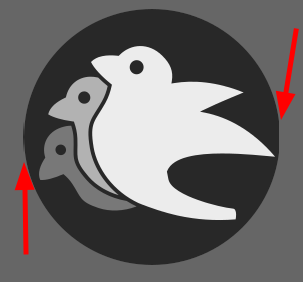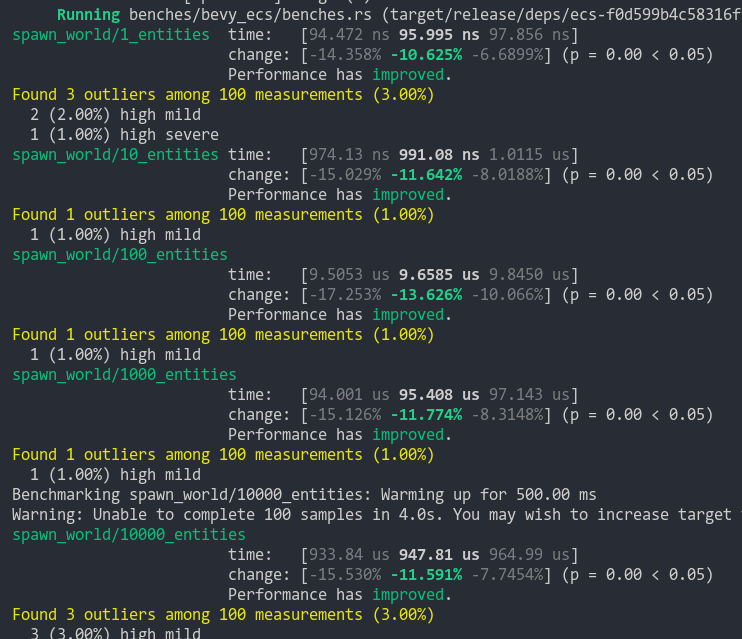2022-05-16 13:53:20 +00:00
|
|
|
//! Displays a single [`Sprite`], created from an image, but flipped on one axis.
|
|
|
|
|
|

Add Sprite Flipping (#1407)
OK, here's my attempt at sprite flipping. There are a couple of points that I need review/help on, but I think the UX is about ideal:
```rust
.spawn(SpriteBundle {
material: materials.add(texture_handle.into()),
sprite: Sprite {
// Flip the sprite along the x axis
flip: SpriteFlip { x: true, y: false },
..Default::default()
},
..Default::default()
});
```
Now for the issues. The big issue is that for some reason, when flipping the UVs on the sprite, there is a light "bleeding" or whatever you call it where the UV tries to sample past the texture boundry and ends up clipping. This is only noticed when resizing the window, though. You can see a screenshot below.

I am quite baffled why the texture sampling is overrunning like it is and could use some guidance if anybody knows what might be wrong.
The other issue, which I just worked around, is that I had to remove the `#[render_resources(from_self)]` annotation from the Spritesheet because the `SpriteFlip` render resource wasn't being picked up properly in the shader when using it. I'm not sure what the cause of that was, but by removing the annotation and re-organizing the shader inputs accordingly the problem was fixed.
I'm not sure if this is the most efficient way to do this or if there is a better way, but I wanted to try it out if only for the learning experience. Let me know what you think!
2021-03-03 19:26:45 +00:00
|
|
|
use bevy::prelude::*;
|
|
|
|
|
|
|
|
|
|
fn main() {
|
2021-07-27 20:21:06 +00:00
|
|
|
App::new()
|

Add Sprite Flipping (#1407)
OK, here's my attempt at sprite flipping. There are a couple of points that I need review/help on, but I think the UX is about ideal:
```rust
.spawn(SpriteBundle {
material: materials.add(texture_handle.into()),
sprite: Sprite {
// Flip the sprite along the x axis
flip: SpriteFlip { x: true, y: false },
..Default::default()
},
..Default::default()
});
```
Now for the issues. The big issue is that for some reason, when flipping the UVs on the sprite, there is a light "bleeding" or whatever you call it where the UV tries to sample past the texture boundry and ends up clipping. This is only noticed when resizing the window, though. You can see a screenshot below.

I am quite baffled why the texture sampling is overrunning like it is and could use some guidance if anybody knows what might be wrong.
The other issue, which I just worked around, is that I had to remove the `#[render_resources(from_self)]` annotation from the Spritesheet because the `SpriteFlip` render resource wasn't being picked up properly in the shader when using it. I'm not sure what the cause of that was, but by removing the annotation and re-organizing the shader inputs accordingly the problem was fixed.
I'm not sure if this is the most efficient way to do this or if there is a better way, but I wanted to try it out if only for the learning experience. Let me know what you think!
2021-03-03 19:26:45 +00:00
|
|
|
.add_plugins(DefaultPlugins)
|
2023-03-18 01:45:34 +00:00
|
|
|
.add_systems(Startup, setup)
|

Add Sprite Flipping (#1407)
OK, here's my attempt at sprite flipping. There are a couple of points that I need review/help on, but I think the UX is about ideal:
```rust
.spawn(SpriteBundle {
material: materials.add(texture_handle.into()),
sprite: Sprite {
// Flip the sprite along the x axis
flip: SpriteFlip { x: true, y: false },
..Default::default()
},
..Default::default()
});
```
Now for the issues. The big issue is that for some reason, when flipping the UVs on the sprite, there is a light "bleeding" or whatever you call it where the UV tries to sample past the texture boundry and ends up clipping. This is only noticed when resizing the window, though. You can see a screenshot below.

I am quite baffled why the texture sampling is overrunning like it is and could use some guidance if anybody knows what might be wrong.
The other issue, which I just worked around, is that I had to remove the `#[render_resources(from_self)]` annotation from the Spritesheet because the `SpriteFlip` render resource wasn't being picked up properly in the shader when using it. I'm not sure what the cause of that was, but by removing the annotation and re-organizing the shader inputs accordingly the problem was fixed.
I'm not sure if this is the most efficient way to do this or if there is a better way, but I wanted to try it out if only for the learning experience. Let me know what you think!
2021-03-03 19:26:45 +00:00
|
|
|
.run();
|
|
|
|
|
}
|
|
|
|
|
|
2021-12-14 03:58:23 +00:00
|
|
|
fn setup(mut commands: Commands, asset_server: Res<AssetServer>) {
|

Spawn now takes a Bundle (#6054)
# Objective
Now that we can consolidate Bundles and Components under a single insert (thanks to #2975 and #6039), almost 100% of world spawns now look like `world.spawn().insert((Some, Tuple, Here))`. Spawning an entity without any components is an extremely uncommon pattern, so it makes sense to give spawn the "first class" ergonomic api. This consolidated api should be made consistent across all spawn apis (such as World and Commands).
## Solution
All `spawn` apis (`World::spawn`, `Commands:;spawn`, `ChildBuilder::spawn`, and `WorldChildBuilder::spawn`) now accept a bundle as input:
```rust
// before:
commands
.spawn()
.insert((A, B, C));
world
.spawn()
.insert((A, B, C);
// after
commands.spawn((A, B, C));
world.spawn((A, B, C));
```
All existing instances of `spawn_bundle` have been deprecated in favor of the new `spawn` api. A new `spawn_empty` has been added, replacing the old `spawn` api.
By allowing `world.spawn(some_bundle)` to replace `world.spawn().insert(some_bundle)`, this opened the door to removing the initial entity allocation in the "empty" archetype / table done in `spawn()` (and subsequent move to the actual archetype in `.insert(some_bundle)`).
This improves spawn performance by over 10%:

To take this measurement, I added a new `world_spawn` benchmark.
Unfortunately, optimizing `Commands::spawn` is slightly less trivial, as Commands expose the Entity id of spawned entities prior to actually spawning. Doing the optimization would (naively) require assurances that the `spawn(some_bundle)` command is applied before all other commands involving the entity (which would not necessarily be true, if memory serves). Optimizing `Commands::spawn` this way does feel possible, but it will require careful thought (and maybe some additional checks), which deserves its own PR. For now, it has the same performance characteristics of the current `Commands::spawn_bundle` on main.
**Note that 99% of this PR is simple renames and refactors. The only code that needs careful scrutiny is the new `World::spawn()` impl, which is relatively straightforward, but it has some new unsafe code (which re-uses battle tested BundlerSpawner code path).**
---
## Changelog
- All `spawn` apis (`World::spawn`, `Commands:;spawn`, `ChildBuilder::spawn`, and `WorldChildBuilder::spawn`) now accept a bundle as input
- All instances of `spawn_bundle` have been deprecated in favor of the new `spawn` api
- World and Commands now have `spawn_empty()`, which is equivalent to the old `spawn()` behavior.
## Migration Guide
```rust
// Old (0.8):
commands
.spawn()
.insert_bundle((A, B, C));
// New (0.9)
commands.spawn((A, B, C));
// Old (0.8):
commands.spawn_bundle((A, B, C));
// New (0.9)
commands.spawn((A, B, C));
// Old (0.8):
let entity = commands.spawn().id();
// New (0.9)
let entity = commands.spawn_empty().id();
// Old (0.8)
let entity = world.spawn().id();
// New (0.9)
let entity = world.spawn_empty();
```
2022-09-23 19:55:54 +00:00
|
|
|
commands.spawn(Camera2dBundle::default());
|
|
|
|
|
commands.spawn(SpriteBundle {
|
2023-11-04 02:09:23 +00:00
|
|
|
texture: asset_server.load("branding/bevy_bird_dark.png"),
|
2021-03-23 00:23:40 +00:00
|
|
|
sprite: Sprite {
|
|
|
|
|
// Flip the logo to the left
|
|
|
|
|
flip_x: true,
|
|
|
|
|
// And don't flip it upside-down ( the default )
|
|
|
|
|
flip_y: false,
|
2022-03-01 20:52:09 +00:00
|
|
|
..default()
|
2021-03-23 00:23:40 +00:00
|
|
|
},
|
2022-03-01 20:52:09 +00:00
|
|
|
..default()
|
2021-03-23 00:23:40 +00:00
|
|
|
});
|

Add Sprite Flipping (#1407)
OK, here's my attempt at sprite flipping. There are a couple of points that I need review/help on, but I think the UX is about ideal:
```rust
.spawn(SpriteBundle {
material: materials.add(texture_handle.into()),
sprite: Sprite {
// Flip the sprite along the x axis
flip: SpriteFlip { x: true, y: false },
..Default::default()
},
..Default::default()
});
```
Now for the issues. The big issue is that for some reason, when flipping the UVs on the sprite, there is a light "bleeding" or whatever you call it where the UV tries to sample past the texture boundry and ends up clipping. This is only noticed when resizing the window, though. You can see a screenshot below.

I am quite baffled why the texture sampling is overrunning like it is and could use some guidance if anybody knows what might be wrong.
The other issue, which I just worked around, is that I had to remove the `#[render_resources(from_self)]` annotation from the Spritesheet because the `SpriteFlip` render resource wasn't being picked up properly in the shader when using it. I'm not sure what the cause of that was, but by removing the annotation and re-organizing the shader inputs accordingly the problem was fixed.
I'm not sure if this is the most efficient way to do this or if there is a better way, but I wanted to try it out if only for the learning experience. Let me know what you think!
2021-03-03 19:26:45 +00:00
|
|
|
}
|